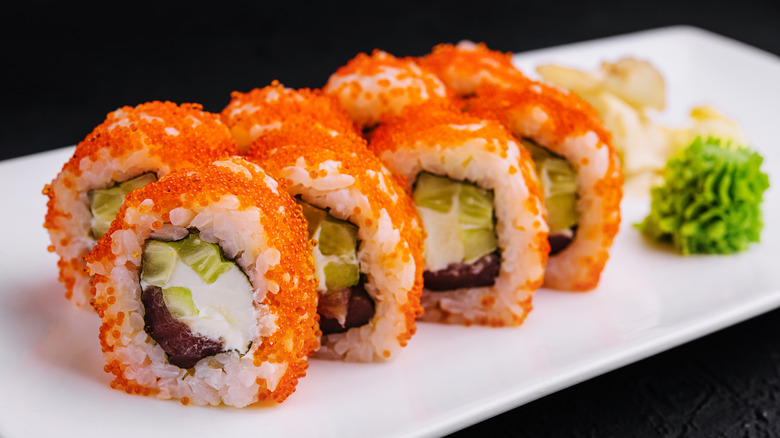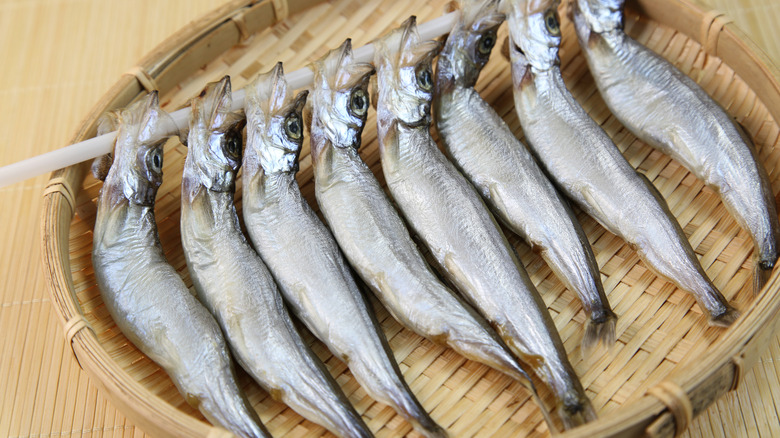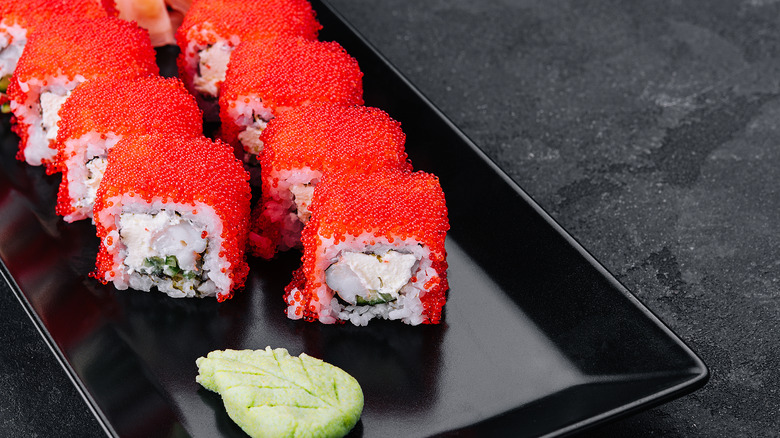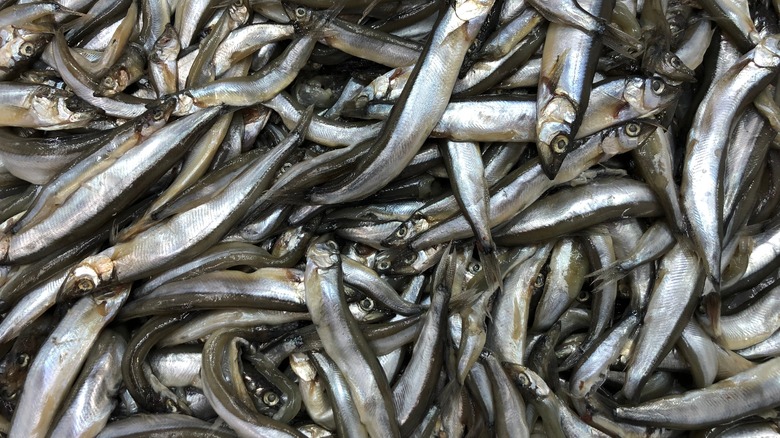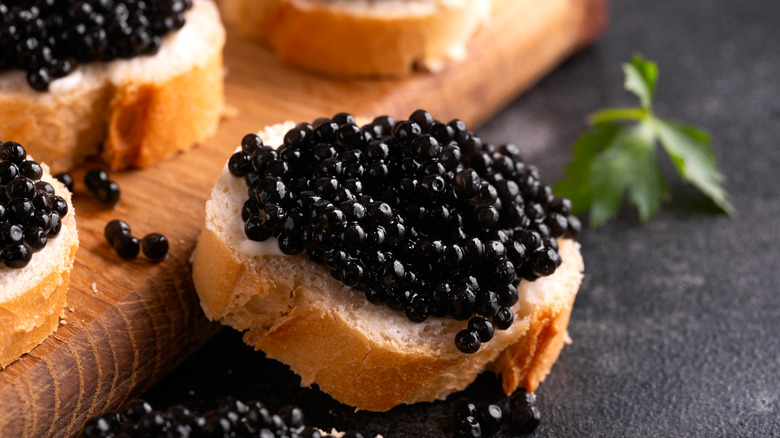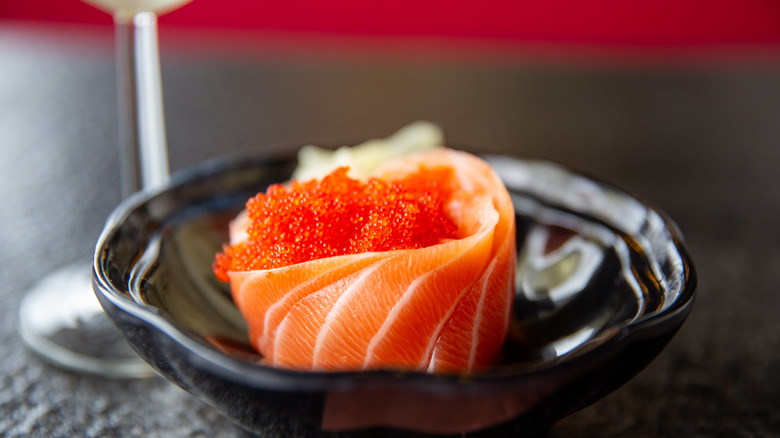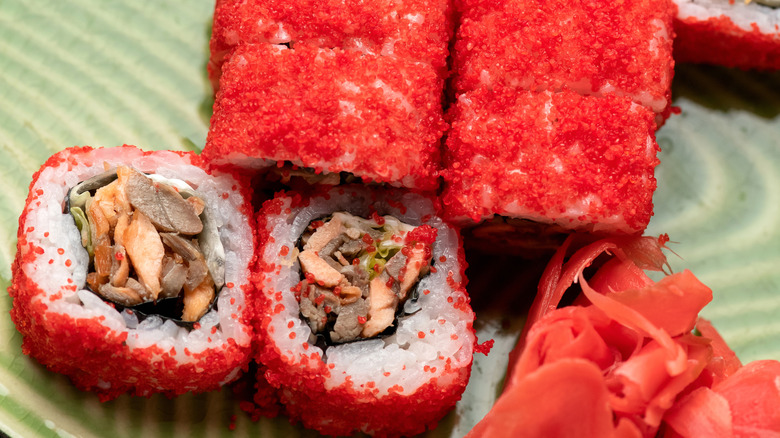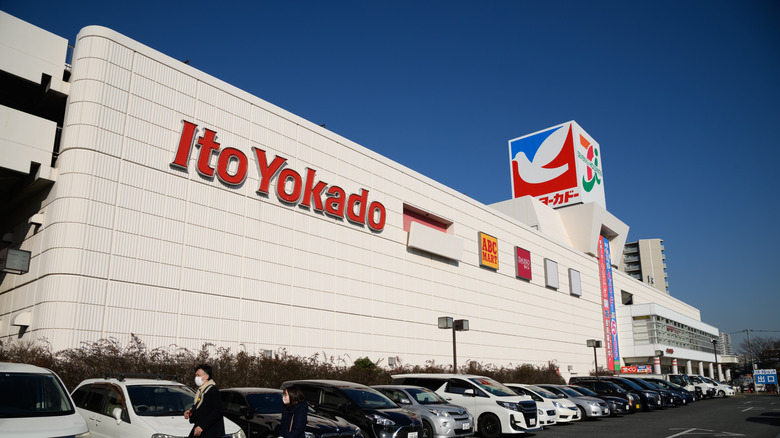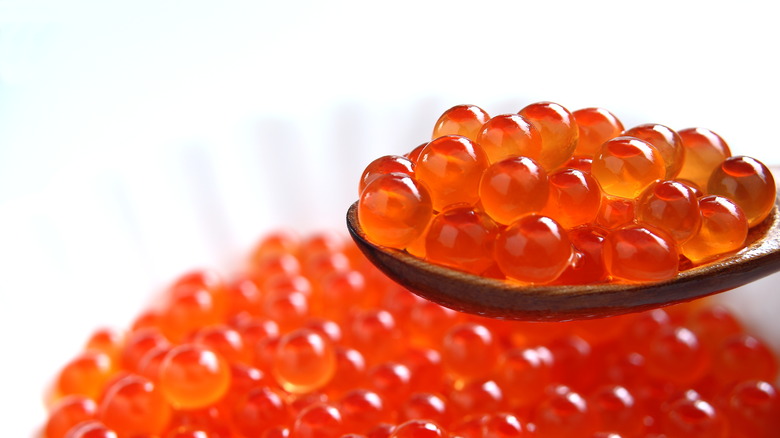What Is Masago And How Does It Compare To Caviar?
The rise of sushi in America has been a meteoric one over the past several decades. Though it first achieved regional popularity in California as far back as the 1960s, it wasn't until the '80s that it started to make inroads in the rest of America. From the later part of that decade on, though, it particularly exploded — which isn't surprising, considering it's both tasty and totally unique relative to any other food to which Americans might have access. That uniqueness has to do with preparation techniques, of course — but it also has to do with ingredients Americans had never seen before.
One of the perfect examples of this phenomenon is masago. If you've been to a sushi bar before, you've seen masago even if you haven't eaten it; they're little orange balls of fish eggs either served by themselves or as a garnish to sushi rolls, sashimi, or other dishes. But if they're fish eggs, does that make them caviar? Well, no; they're really their own thing.
What is masago?
Masago is very specifically a type of roe (fish eggs) belonging to one particular species of fish — the capelin. You may not have heard of the capelin, but it's a type of smelt typically found in the North Atlantic, North Pacific, and Arctic oceans. Capelin can themselves be eaten (they taste something like herring), but they don't commonly pop up in cultures not closely associated with the regions where they're from, except for a couple.
Capelin typically aren't eaten whole in Japan, but they're still highly prized among Japanese cuisine because of the use of their roe in sushi. Masago pops up in various forms in sushi, whether served in Japan or other countries. But you're not likely to see masago in most other cuisines — no surprise since masago is itself a Japanese word. The notable exception here is Korean cuisine, which sometimes makes use of both masago and capelin.
How is masago made?
Masago can't itself be grown; we're talking about an egg here, so you have to harvest it from the creature itself. Typically, they're harvested from female capelin just before they've had a chance to spawn, when their egg content is highest. And "high" here may be an understatement because each capelin can contain between 6,000 and 30,000 eggs. Sure, each egg is tiny, but considering masago isn't used in huge quantities, that means each capelin contains a pretty significant amount of the stuff.
Though capelin live in a few different oceans, most of the fish (and thus the masago) are harvested from the Atlantic, particularly in the Greenland-Iceland-Norway triangle. Once gathered, the main commercial change they go through is coloration: masago is naturally white or pale yellow, but it takes well to food coloring and is usually turned orange, red, green, or black to increase its aesthetic appeal.
Is masago sustainably caught?
Sustainability is a huge issue in seafood; fishing doesn't create as many ecological issues as the mass production of beef or pork, but because most fish are wild-caught, population decline is always a concern. Whether masago is a sustainably caught fish, though, kind of depends on who you ask. Because only females of the species are targeted for harvesting, gathering masago has a significant effect on the species' gender disparity, which can have downstream knock-on effects. They're also sensitive to environmental changes, which means overfishing is always a concern. Since capelin is a major component in the oceanic food chain because it's food for a lot of larger fish, there are also even more significant concerns here.
Nevertheless, as long as it's not heavily overfished, masago is regarded as a sustainable seafood product (especially in comparison to many other types of fish roe). But it's something to keep an eye on in case the scale tips to the other side.
Masago vs. caviar
Both masago and caviar are types of roe — but both refer to a specific thing. Caviar is usually regarded as roe from any fish in the Acipenseridae family, which includes sturgeon as well as paddlefish. Technically, a lot of fish roe can be referred to as caviar; salmon, steelhead, trout, lumpfish, whitefish, and carp roe are all occasionally called "caviar." In traditional practice, though, caviar refers explicitly to the eggs of the wild sturgeon found in the Caspian Sea and the Black Sea — meaning the beluga sturgeon, ossetra sturgeon, and starry (sevruga) surgeon species.
Beyond simply the definition, the two are regarded very differently in cooking. Masago is relatively cheap and used as much for its colorful properties as its flavorful ones. Caviar, meanwhile, isn't particularly visually striking, but its rarity makes it highly prized and extremely expensive. Caviar, which comes in different grades, can sell for up to $50 to $150 per ounce, meaning it's not an everyday meal. Historically, it was typically regarded as a dish of royalty, particularly the Russian czars.
What does masago taste like?
Though various kinds of roe have their own unique tastes, they all share one quality: saltiness. While something like caviar might hit you with a heavy, salty punch, masago is, in comparison, much lighter. This is important because, given how it's used in conjunction with sushi rolls, some stronger types of fish eggs would overwhelm the light, subtle flavors involved. Texturally, meanwhile, they're hard to describe in comparison to anything else; their texture is solid enough that they're slightly crunchy, and you really can feel the individual eggs (even if they're tiny) as they kind of burst when you eat them.
Though there are a lot of different kinds of roe used in sushi, tobiko, or flying fish roe, is probably the most similar to masago. Even though they come from completely different fish, they taste and look so similar that they are often used interchangeably. The main difference is texture; tobiko tends to be smaller and even crunchier than masago.
How to cook with masago
Technically, you don't typically cook with masago, per se; exposing the eggs to heat will cause them to disintegrate. Theoretically, you could, as certain types of roe get cooked – uni, or sea urchin roe, is sometimes turned into a butter used as a sauce component. But that's typically not how to use the ingredient in cuisine. You could, however, mix it into rice or noodle dishes.
The most common usage of masago is as a garnish, potentially after being combined with something like corn syrup or MSG (which, contrary to what many people seem to think, is not dangerous at all). Masago's introduced bright color makes it an aesthetically pleasing addition to various types of sushi rolls, and its mild salty taste means it adds a flavor component to the dish without overwhelming it. In addition to coating a sushi roll or topping a poke bowl, you might also see masago on its own in nigiri sushi, with seaweed used to create a pocket for a large quantity of masago over a small bed of rice.
Health benefits and downsides of masago
Masago has a surprising number of health benefits associated with it. It's believed to boost energy levels and nerve health, and its low caloric content means it won't cause weight gain. It's also (like many types of fish) a rich source of vitamins B12 and D, and omega-3 fatty acids. In addition, capelin is much lower in mercury compared to a lot of fish, so that's far less of a concern than with many other kinds of seafood.
There are, however, a few potential downsides. The risk of allergic reactions is a concern, as with any type of seafood, but the main thing here is the sodium content: Masago is absolutely laden with the stuff. Excess sodium consumption is associated with increased blood pressure as well as the risk of heart disease and strokes, so you don't want to overindulge.
Where to buy masago
Here comes the bad news for fans of fish eggs. Because it's a specialized ingredient, you're not likely to see masago at your local grocery store (at least not if you live in America); just because it's not nearly as expensive as caviar doesn't mean it's super easy to find. Though it's also highly perishable (no surprise here, considering it's seafood that hasn't been canned), there are places you can order it online; just be sure to get overnight delivery and use it quickly, as it will rapidly spoil.
The easiest way to find it, though, is simply to go to your local specialty Japanese grocery store. If anywhere is going to have it, it'll be a shop like that, and you're likely to get it for a more affordable price than the $4-6 per ounce it costs online (not including shipping costs).
Other varieties of masago
There are a ton of different sushi-grade varieties of roe used in Japanese cooking; masago is far from the only one available. Ikura is salmon roe; if you've ever seen the big orange balls in sushi, that's this one. Uni, which is having a huge moment, is a sea urchin's reproductive organs — meaning it technically qualifies as roe. Mentaiko is Alaskan pollock roe, typically spiced with powdered red pepper, while tanako is salted roe from the same fish. Kazunoko, or herring roe, might be the most unusual: It tends to have a firm texture that forms a cohesive mass, meaning it's served like a piece of fish. Though each serves a similar purpose, they're all different — which isn't surprising, considering they come from different fish species.
Whichever variety of roe you sample as part of your sushi experience, each brings a unique flavor. They might not have quite the international reputation of caviar, but that doesn't mean they're not delicious.
